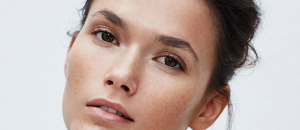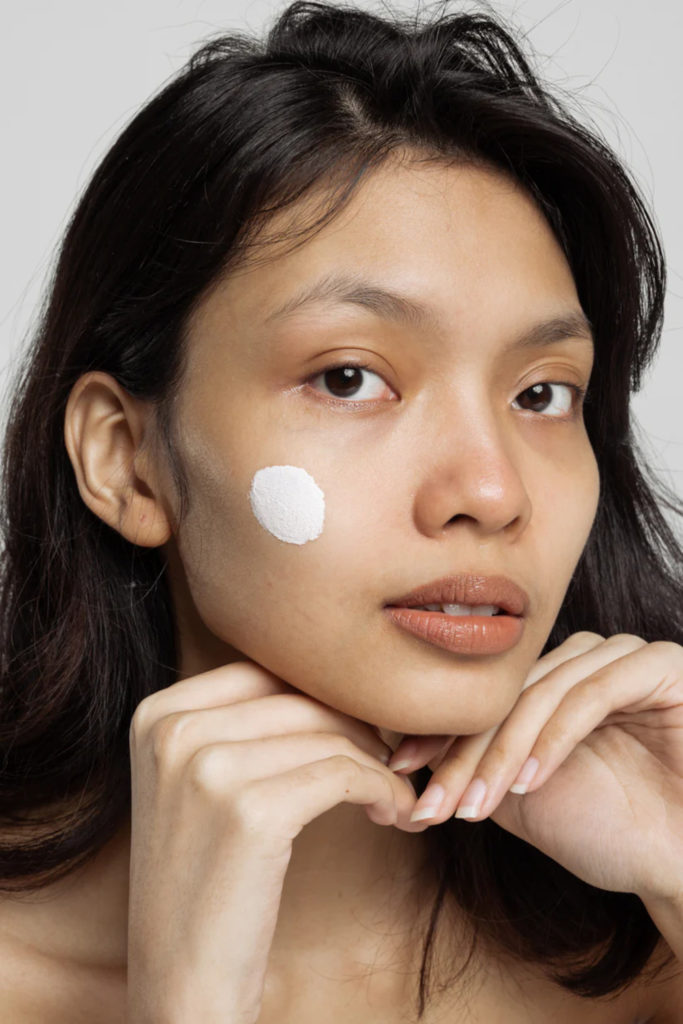
Everything You Need To Know About Polynucleotides, According To Experts
By
12 months ago
The infamous salmon sperm treatment, explained
Let’s talk polynucleotides. This injectable skin booster is quickly becoming the most sought-after treatment of 2024, but how much do we actually know about it? We’ve asked the experts everything we need to know about polynucleotides, from what we can expect during the procedure to benefits, downtime and pricing. Read on for all the details.
A Guide To Polynucleotides
What Are Polynucleotides?
‘Polynucleotides are an injectable, skin-boosting, regenerative treatment,’ explains medical and cosmetic doctor, Dr Leah Totton, founder of Dr Leah Cosmetic Skin Clinics and Dr Leah Skincare. ‘They help improve the skin quality on a cellular level and can be used to hydrate the skin, treat dark under-eye circles and fine lines around the eyes and lips, rejuvenate scars or improve overall texture to give skin a healthy glow. A needle or cannula is used to carefully inject the polynucleotides solution into the under eye area, cheeks, around mouth or neck, with the injections strategically placed to stimulate collagen production, improve skin texture and reduce the appearance of fine lines, wrinkles and dark circles under eyes.’
What’s In It?
As we’ve mentioned, polynucleotides use salmon DNA – more specifically, salmon sperm. ‘Polynucleotides are derived from salmon sperm,’ confirms aesthetic Dr Ivy, an aesthetic doctor at 111 Harley St. ‘After being extracted from the gonads, the salmon DNA is distilled, purified and mixed into a water formula, before being injected into the skin. The main goal is to improve quality of the skin and to use in areas where loss of volume due to ageing is not a factor.’
‘Within polynucleotides, you’ll find a complex mix of nucleotides, which are the building blocks of DNA,’ adds Dr Joney De Souza. ‘This composition triggers various biological processes in the skin, including collagen and elastin synthesis, hydration enhancement, and overall tissue repair.’
@drkatebennettbrown Polynucleotides 🪄 the magic skincare treatment that improves skin health and quality #polynucleotides #polynucleotides #skincareroutine #skincaretips ♬ original sound – drkatebennettbrown
What Are The Benefits?
Aside from skin rejuvenation, polynucleotides are praised for their ability to improve skin texture, reduce fine lines and wrinkles, enhance skin elasticity and even out skin tone – as well accelerate wound healing and reduce the appearance of scars.
‘Polynucleotide treatments increase cell turnover, which is essential for maintaining healthy and rejuvenated looking skin,’ highlights Dr Leah. ‘They can also reduce the pigmentation and discoloration that contribute to the appearance of dark circles under the eyes, promote great skin elasticity, and stimulate higher hyaluronic acid synthesis (ensuring that the treated area remains hydrated and plump) as well as collagen and elastin production.’
Are There Any Side Effects?
Although there aren’t any major side effects to note down, you should (as with any aesthetic treatment) expect some kind of recovery period. ‘As with any skincare treatment, there may be some side effects to consider,’ explains Dr Joney. ‘These can include temporary redness, swelling, or bruising at the injection site. However, these effects are usually mild and transient, resolving within a few days.’
It’s also worth making a note of any allergies you have, especially if they are related to fish. ‘With any treatment a medical questionnaire should be completed ahead of time, citing allergies,’ says Dr Ivy. ‘Polynucleotides are not suitable for people with fish allergies. In such cases, we would recommend Profhilo as an alternative. Other side effects, although rare, can include tenderness at the injection point, slight redness and itching.’
Is There Any Downtime?
‘There is the possibility of bruising and swelling when injected with a needle, and this may require a few days to recover,’ confirms Dr Leah. ‘However, when done with a cannula there is less downtime needed, and is typically 12 to 24 hours.’
Polynucleotides vs Profhilo
Speaking of Profhilo, it’s often compared to polynucleotides treatments as an alternative – but how do they differ, and what sets polynucleotides apart from other skin boosters? ‘Profhilo and Polynucleotides are both popular injectable treatments but differ in their compositions,’ explains Dr Ivy. ‘While both help address skin laxity and boost hydration, polynucleotides offer the added advantage of promoting cellular repair and regeneration due to their unique DNA derived structure. Profhilo helps with hydration and promotes collagen production. Profhilo, for the face, also has set injection points, which the practitioner adheres to.’
‘While both aim to rejuvenate the skin, Profhilo primarily consists of hyaluronic acid, which provides intense hydration and stimulates collagen production. Polynucleotides, on the other hand, target a broader range of skin concerns by promoting cellular repair and regeneration,’ adds Dr Joney. ‘Whether polynucleotides are superior to Profhilo depends on the individual’s specific skincare needs and goals. In some cases, combining both treatments may yield optimal results, as they complement each other’s actions.’
@doctortego One of my hottest treatments currenlty for biostimulation – pushing your own skin cells to do the work and produce more collagen and hyaluronic acid, rejuvenating your skin 😍 #skinbooster #polynucleotide #undereyetreatment ♬ SUCCESS – $werve
Where Are Polynucleotides Injected?
Below, Dr Leah outlines all the places on the body polynucleotides are currently used, and how they improve the quality of skin:
- Eyes: ‘Polynucleotides are a highly effective treatment for reducing dark circles under the eyes, and smoothing crow’s feet, fine lines, hollows and puffiness beneath the eyes,’ says Dr Leah.
- Forehead: ‘It can also smooth fine lines on the forehead, encourage glowing skin and can be used as an alternative to popular anti wrinkle injections.’
- Mouth: ‘Polynucleotides smooth lines around the mouth (aka, “smokers lines”) without plumping or adding volume.’
- Scars: ‘This is a treatment that can be used to treat scars anywhere on the body, as well.’
- Jawline: ‘It’s also great if you need some help tightening the jawline.’
- Neck: ‘The treatment can also treat fine lines on the neck, as well as addressing crepey-looking skin on the décolletage.’
Who Can Receive Treatments?
You’ll be pleased to know that, for the most part, anyone can try it out. ‘Suitable candidates for polynucleotide treatments are generally individuals seeking skin rejuvenation, improvement of skin texture and tone, and reduction of fine lines and wrinkles,’ says Dr Joney. ‘However, it’s essential to consult with a qualified aesthetic practitioner to determine if this treatment is suitable for your unique skin concerns.’
‘It’s a popular treatment amongst those aged 35 and over, although we’ve noticed younger clients who wish to get an overall skin rejuvenation and glow give it a go,’ adds Dr Leah. ‘While polynucleotides can reduce fine lines and wrinkles, those who are looking to address sagging skin may be more suited for a lifting treatment. People who are younger than 30 may seek polynucleotide treatment as a result of premature ageing, as a preventative ageing measure, or to improve skin quality.’
As for those who shouldn’t try polynucleotides, Dr Leah says that ‘this treatment is not suitable for those pregnant or breastfeeding, and also vegans as it is an animal derived product.’
What Happens During Treatment?
Any aesthetic treatment is typically preceded by some kind of consultation to assess if it’s right for you. ‘Before any treatment, a thorough consultation and assessment will take place,’ says Dr Leah. ‘This allows us to understand the patient’s concerns, expectations, and desired outcomes – this also means we can advise if polynucleotide treatment is the best treatment for them. We can then assess the area the patient wants to treat (under-eye, cheeks, around mouth or neck).’
As for the treatment itself: ‘Polynucleotide treatments typically involve a series of injections directly into the targeted areas of the skin,’ explains Dr Joney. ‘The procedure is relatively quick and minimally invasive, often performed in-office with little to no downtime.’
‘It depends on the individual patient, but typically two to three polynucleotide treatments will be required, each two to four weeks apart,’ says Dr Leah. ‘During the treatment itself, a needle or cannula will be used to carefully inject the polynucleotides solution into the under eye area, cheeks, around mouth or neck. The injections are strategically placed to stimulate collagen production, improve skin texture, and reduce the appearance of fine lines, wrinkles or dark circles under eyes.’
How Often Should You Get Polynucleotide Treatments?
For most people, you’ll need a couple rounds of treatment to really see results kick in. ‘We recommend a series of two treatments for all patients for optimum results,’ says Dr Ivy. ‘In some cases a third treatment is added depending on the individual. These are spaced a few weeks apart.
‘Following the initial series, it is recommended to come back in six to nine months as maintenance,’ she continues. ‘What you will see is a gradual improvement in skin quality, reduction in fine lines and wrinkles, decrease in pigmentation and enhanced elasticity of the skin. However, results vary from person to person depending on individual metabolism and lifestyle choices.’
‘For the best results, I advise a top-up single treatment every six to 12 months to sustain the results, but generally the results last up to a year,’ adds Dr Leah.
@drtash.skinenhance Replying to @Jennifer.loves.travel #polynucleotides #answeringyourquestions #doctor #skindoctor #skinclinic #billericay ♬ original sound – Dr Tash
How Quickly Can You See Results?
As mentioned, how quickly results set in can vary from person to person – but, generally speaking, you can expect a pretty quick turnaround. ‘Results from polynucleotide treatments can be seen relatively quickly, with noticeable improvements in skin texture and tone within a few weeks,’ confirms Dr Joney. ‘The duration of results varies depending on individual factors such as skin type, age, and lifestyle habits but generally lasts several months to a year.’
Are There Any Treatments That Complement Polynucleotides?
Our experts generally agree that clients can benefit from combining polynucleotides with other clinical treatments. ‘I always combine treatments,’ says Dr Ivy. ‘Every patient is unique and deserves a bespoke approach for best results. I combine polynucleotides with other injectable treatments, with strategic placement, taking into account facial structure and angles, for natural looking, rejuvenated results. The combination treatments may include Botox, dermal fillers and Profhilo, depending on the person and their specific needs.’
As for at-home treatments, Dr Joney recommends, ‘skincare products containing growth factors, antioxidants, and sunscreen to maintain and protect the skin.’
How To Choose A Practitioner
And when it comes to finding the right practitioner for your, Dr Ivy recommends: ‘Research and word of mouth. You should ensure they are a registered practitioner. When in doubt, ask for patient references and before and after photos.’
‘Patients should thoroughly research the clinic and the practitioner before undergoing the treatment,’ highlights Dr Leah. ‘It’s crucial to inquire about the qualifications and experience of the staff. Ensure the doctor has a licence to practise in the UK.
‘A good rapport between the cosmetic doctor and patient is key, as there is a huge element of trust,’ she continues. ‘This can be determined in the consultation. When doing your research, always ensure you have a consultation before going ahead with the treatment.’
How Much Do Polynucleotides Treatments Cost?
The cost of polynucleotide treatments varies from clinic to clinic, so we asked our experts what kind of range we should expect: ‘The price of treatment depends on several factors, including the quality of the polynucleotide product offered,’ says Dr Leah, whose treatment costs between £850 and £1,200 for two to three vials of polynucleotide. ‘Here, we prioritise quality of products and doctors over providing the cheapest service. ‘
If you’re unsure, you can always book a consultation with your clinic of choice to discuss options. ‘It’s best to schedule a consultation with a qualified practitioner to receive an accurate quote based on your individual needs,’ emphasises Dr Joney.
Featured image: Marcos Paulo Prado, Unsplash










